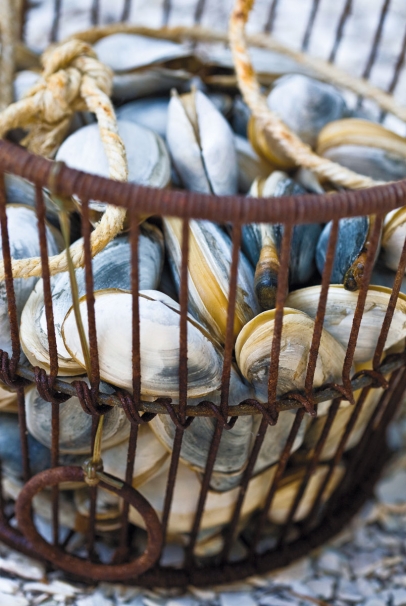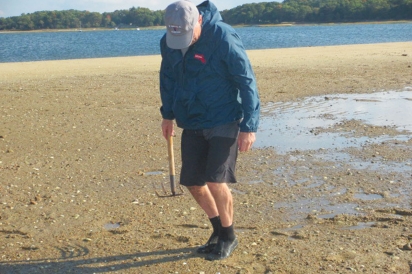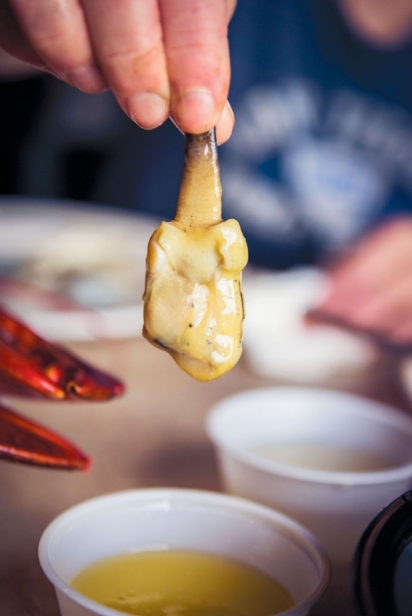A Good Mess of Clams
Hosting neighborhood clambakes was an important part of the summer for my family. My memories of these well-rehearsed affairs go back to early childhood and are vivid even now, some five decades later.
Beginning a few days before the actual feed, there’d be a trip to a specific, local farm stand to buy corn. Breakfast sausage meat would be purchased from a nearby deli counter. Shopping lists included cheesecloth and paper napkins, sweet and white potatoes, onions, hot dogs, canned brown bread and watermelon. Someone was assigned the chore of going to the banks of Cape Cod Canal for rockweed (the kind with air poppers), and someone else was responsible for getting ice. Then there was the main event, of course: soft-shelled clams.
Everyone in the neighborhood with a license and the wherewithal to dig headed to the intertidal areas of our Wareham shorelines and brought up their allowed peck of clams. These steamers, Mya arenaria, were the centerpiece of the bake, and as fertile flats were just a quarter mile from where we lived, it was simply outside the realm of consideration to buy them. They could be expensive then as they are now.
You could count on two things when the Saturday of the actual bake came around. The first was when all the shellfish were heaped on the picnic table to be hose-rinsed of sand, my father would eye the pile with admiration and pronounce, “Now that’s a good mess of clams.”
The other surety was that despite all the detailed preparation, someone had to make a last minute run to the store because they forgot to get the second-most important ingredient in the bake: butter. And heaven help the naïve shopper who came back with margarine. It had to be real butter—no ifs, ands or buts.
The clambakes involved three, sometimes four dozen people, and were communal events. Subgroups formed naturally where one husked corn, another dug the hole for the fire pit and another filled up coolers with ice and soda and enough cans of beer to hold up indefinitely. Tables were carried in and arranged in long rows.
Kids of all ages played games that added to the swirl of activity. This happy community exerted themselves for hours until finally, when the stones that had been placed in the fire were hot enough, all the food and seaweed was strategically placed on top of them and covered with a soaking wet canvas tarp to trap a head of hot, hissing steam.
The work, which was not considered work, was performed with the idea of providing their families with a delicious, native experience, and having opportunity to participate in a bonding event.
When you saw everyone dive voraciously into the steamed clams, however, chins dripping with molten butter that glistened in the sun, it was difficult to say which was the more anticipated: the lasting effect of spending quality time with your fellow dwellers or the more transitory sensation of eating all the steamed clams you could in one sitting.
The soft-shelled clam, a species of edible saltwater clam, is a marine bivalve mollusk in the family Myidae. Its thin, calcium carbonate, chalky white shell (shells can be easily broken, hence the name soft shell) with uneven concentric rings is Cape Cod iconic. From Provincetown to Bourne, steamers can be found in those restaurants and clam shacks that make efforts to provide authenticity.
For many who weekend or summer on the Cape, their trip to paradise is incomplete until they’ve found time to dine on this real deal. Soft-shell clams—a.k.a. pissers, Ipswich clams, belly clams, longnecks and nannynose—with a sweet and slightly salty, herballynutty taste, are part of the reason that weekly ten-mile-long traffic snarls develop getting on and off the Bourne and Sagamore Bridges that span the canal. It is not hyperbole to aver that clams here are the best in the world. Once you’ve had them, you come to understand that the people you’ve seen hunched over, digging in the mud on the frozen shorelines in the winter, are not certifiably crazy. They’re just crazy about the taste of clams.
There are three ways to use soft-shell clams. One, you can do the work to shuck them for chowder, although in so doing you may find yourself eating bits of beach sand they’ve siphoned in while feeding. (Tip: add salt to water and soak for a few hours before eating to allow the clams the opportunity to expel the sand they’ve ingested.) You’ll also have to shuck a lot of clams for a little chowder because soft-shell clams will not provide the same amount of meat that hard-shell or sea clams do.
Two, you can bread or batter them for deep-frying. And by frying I mean the whole clam—bellies and all—because purists are correct in asserting that the whole clam must be eaten to exact their true taste. Ordering clam strips only is like choosing a ride on a moped when a Harley Davidson is available. (And after all, clam strips are made from sea clams, not soft-shell clams).
The third and last method is to steam them in water over a heat source. Any other use that deviates too far from this basic trio is unnecessary and runs the risk of taking away from their quintessential sweetness. Clams are so good that once eaten, the inaugural digestive act often represents the beginning of a lifetime craving.
New England is soft-shell clam country. The state of Maine leads the nation with a commercial yield that can exceed six million pounds annually (an average steamer weighs less than one quarter pound). Commercial diggers in Massachusetts, second nationally, pull up over one million pounds, a year. Connecticut and New York are also hotbeds for clams.
Digging clams requires a rake, license, basket and size ring (2-inch length is generally considered the legal minimum for clams). Maintaining a work ethic is an unwritten requirement. The purchase of a local license will provide the opportunity to read written regulations that govern the activity in your town. The amount allowed weekly, the clam’s size, hours of operation and the refilling of holes are some of the more important considerations.
It’s also critical to take note of what areas are open to digging in your town. Red tides, heavy rainfalls, or any gas or oil spills all may result in temporary closures of digging areas because the clams, extending their long necks several inches up through the sand to siphon plankton as food, are filter feeders. Anything in the water becomes part of their food.
Any late afternoon or weekend day represented a clam digging opportunity for my parents, provided low tide synched with the end of work responsibilities. Then, they’d be out the door in hip length boots. Finding a spot to dig was ridiculously easy, because then the clams were prolific and they left telltale holes in the sand through which they’d breathe and eat. When even the slightest pressure was placed on their territory, like taking a single step on the sand, they’d eject seawater through their necks and the streams alerted you to their presence. In fact, this is where the moniker piss clams derived.
Then a hole would be dug with a clam rake, more or less a foot deep, and at that point the real fun began. My parents had both evolved to a sitting or kneeling technique, using their bare hands to dig sideways from the bottom of their holes, creating mini-landslides of mud that revealed clam after clam after clam in their foot down, neck up vertical positions. Flipping their legal size catch into the basket, my parents would reach their limit in no time—a good mess of them—then bring the catch into the water to rinse. Lots of times they’d cut their fingers on the edges of a clam or oyster shell, or get pinched by an occasional fiddler crab, but the small pain was more than worth the reward.
Soft shell clams live on average 7-12 years. They can grow to be three to four inches long. Their lives begin in the water column where sperm and egg unite to form larvae. The larvae swim freely for one to three weeks, vulnerable to currents, wind and wave action, and grow feet and shell during this time. Soon they anchor themselves to the bottom using a byssal thread secreted from their foot. They do this in a manner akin to you looking for a neighborhood, emphasizing location during their search. They prefer areas with food resources, mild wave action and lack of predators.
When they find what they are looking for, they burrow through a combination of using their foot and forceful valve action. They descend several inches and will then remain in this position, sessile, for the rest of their lives. Once settled in, adults cannot rebury themselves if removed. They exist in a sedentary state, eating by pumping as much as ten gallons of seawater per day through inhalant and exhalant siphons. They reach market size in about four years.
The odds of a clam surviving from the larval stage to old age are slim. While a one-year-old female may produce more than a million eggs in a single breeding session, only one-tenth of one percent of all larvae survive to become adults. The filter feeders are susceptible to algal blooms (red tides) and chemical contaminants. Strong storms can suffocate them via heavy displacements of sand that cover their holes. Green crabs are a natural predator, and so are the likes of northern moon snails, sea gulls, horseshoe and blue crabs. Sea robins are capable of digging, and they enjoy feasting on clams too.
And then there is the danger posed by hungry men. In Wareham it is difficult now to find an abundant area like those enjoyed by my parents several decades ago. Residents and vacationers have been ripping up the shore for so long that overfishing has resulted in a depletion of what were once rich areas.
Wareham resident Jim Brogioli served as the town’s deputy harbormaster and shellfish warden for 25 years. He’s also been a recreational digger for most of his life. “The treated wastewater that gets pumped back into the environment, rainfalls that add pollutants to the water, the water temperature and overfishing are all factors that have led to a depletion of this resource, “ he says. “Things are certainly not as they used to be here.”
Adding to these factors are men so hungry for clams that they choose to violate the law. Brogioli has seen people take undersized shellfish, others who try to exceed the weekly limit, unlicensed diggers and some who knowingly cross through private property to access plentiful digging areas.
When a hole is created, the clams under market size are dislodged and are unable to reposition themselves to survive. In fact, nearly half of young clams in the path of clam diggers may die from the encounter. They are left unable to breathe or are vulnerable to opportunistic gulls and oyster catchers gliding in to eat the free, juvenile clam buffet.
Still, the clam has somehow sustained and survived despite the odds. They can withstand below-freezing temperatures. If a female clam lives just a single year, it already has developed the ability to reproduce. And what damage humans have done, we’ve also sought to correct. Localities rarely allow hydraulic dredging for soft-shell clams, a process much more damaging to the sea floor than hand raking.
Most local regulations require the refilling of holes, with the thought that covering the clams with sand will continue to shield them from predators, and the piles of sand left by diggers, if removed, won’t smother any nearby clams either. Chatham’s regulations go so far as to direct diggers to replant undersize clams in the upright position and then cover them with sand. And more commercial diggers are discovering the benefits of using clam tents. Netted structures placed over sand flats, these tents help slow sediment displacement and give clams something to attach to when they are ready to settle down. They also serve as a refuge from surface predators.
Certain clam beds have been designated as management areas. Here, clams that have been bred indoors via thermal shocking (a change in water temperature that initiates spawning) get planted in beds that local authorities are attempting to enhance for their licensed diggers. These areas sometimes limit the number of days people may work them to further promote the growth of soft-shelled clams.
Clams can become contaminated after heavy rainfalls and, thus affected, are not safe to eat. These clams, contaminated with fecal coliform bacteria, may end up in Newburyport, Massachusetts, at the oldest depuration plant in the world. Opened in 1928, it is the only state government-owned-and-operated facility of its kind in the country (there are privately-run facilities). Clams are kept here long enough to purge themselves of dangerous toxins.
The plant processes on average one-third of the total Massachusetts commercial clam production. But those towns that have economic reliance on their coastlines can be better served seeking remediation efforts with their storm water runoff systems. Homeowner and business wastes can be contained before the problem manifests itself in the bays, inlets and estuaries along the shore. It may be the best long-term approach to ensuring that populations of clams will continue to exist.
Both of my parents are gone now, but I’ve made sure the family tradition of clambakes continues. With annual license in hand, my wife and I scan the tide charts to head out for clams. We do clam boils, not bakes (eschewing the pit, stones and tarp), by placing steamers in the bottom of a large pot. Other favorite ingredients—corn, canned brown bread, potatoes, sausage and onion—are packed densely on top of the clams to absorb the flavorful steam as it rises during cooking. Seaweed covers all of this to help trap the steam and pop and release more liquid down into the treasure pot of food. It is a hearty, local and delicious meal, most all of it covered with butter, and gets devoured within minutes.
The tradition extends beyond my own family of five. My two brothers and sister, along with their families, have found an annual summer clambake the reason to get together at least once every year. It’s a communal event with bocce and frisbee games, lots of wine and beer, representing a thread that was woven among all of us and continues to hold us together.
When my dad got too old to hold up to the physical exertion of clam digging, he used to drive to his favorite spots with a pair of binoculars and watch the proceedings to derive vicarious pleasure. I had about finished digging clams one day when he pulled into the parking lot and met me at the shore. His eyes were fixed on my wire mesh basket, not me. His assessment was immediate. “Son,” he said with admiration. “You’ve got yourself a good mess of clams.”






